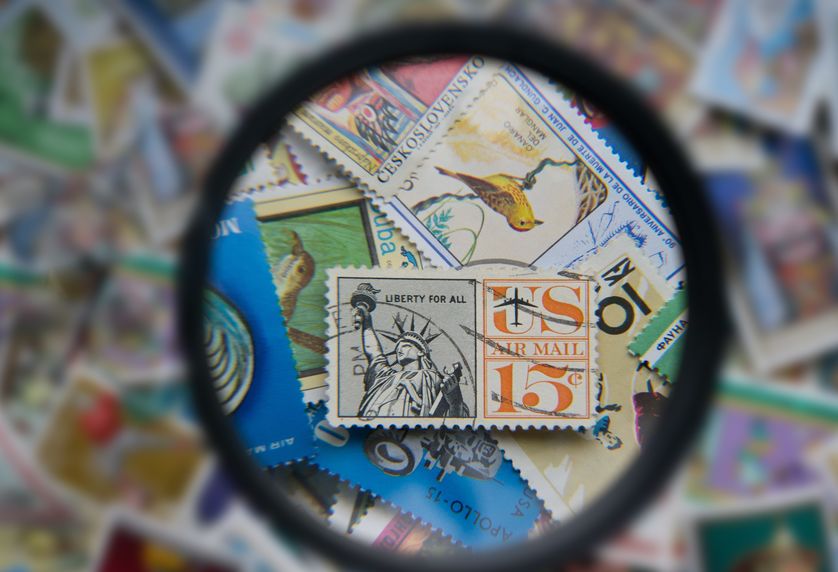If you’ve ever picked up a stamp and wondered if it’s worth something, your first thought might be, “Is it rare?” That’s a fair question—and rarity certainly plays a role in a stamp’s value. But here’s the truth we’ve seen again and again at Centennial Auctions: rarity isn’t everything.
Over the past 30 years, we’ve auctioned thousands of stamps for collectors, estates, and everyday folks who inherited boxes of old envelopes. While rare stamps can be exciting, their true value at auction depends on a mix of other important details—some obvious, some more subtle.
Let’s walk through what matters when it comes to stamp auctions and why things like condition, cancellation marks, and provenance are just as important as scarcity.
Rare Stamps Turn Heads—But That’s Just the Beginning
Let’s start with the obvious. A rare stamp will usually attract some attention. Whether it’s a misprint, a short-run issue, or a piece from a historic era, rarity often sparks curiosity among collectors. But we’ve seen plenty of rare stamps underperform at auction simply because they had other issues—damage, poor presentation, or no supporting documentation.
Think of rarity like a fancy car model—it might be a collector’s dream, but if it’s covered in rust and missing the engine, the value drops fast. The same goes for stamps.
Condition: Where First Impressions Matter Most
If you’ve ever tried to sell collectibles, you know condition is king—and stamps are no different. Even if a stamp is 150 years old and tough to find, a crease, tear, or missing perforation can cut the value in half (or more).
Here’s what serious collectors look for:
- Sharp corners and full perforations
- Bright, unfaded color
- Clean surfaces, no creases or thins
- For unused stamps: intact original gum
- Centering—a stamp that’s printed evenly in the middle of the paper looks better and is more valuable
At Centennial Auctions, our team takes the time to grade and describe stamps honestly. We make sure both buyers and sellers know exactly what they’re dealing with. Because when a stamp is in beautiful shape, it tends to do well—rare or not.
Cancellation Marks: The Story Behind the Ink
Something most people don’t realize is used stamps can be just as valuable as mint ones—sometimes even more so—depending on the cancellation.
Collectors don’t just want the stamp; they want the story. And that postmark can say a lot.
For example:
- A clear, light cancel that doesn’t hide the stamp’s design is usually preferred.
- A postmark from a remote or short-lived post office might be incredibly collectible.
- Stamps canceled during a war, on a first day of issue, or as part of a famous event can carry historical significance that boosts their value.
We’ve seen stamps at Centennial Auctions go well overestimate simply because of an unusual cancel. When buyers spot a postmark that tells a unique story, they get excited—and that means more competitive bidding.
Provenance: When a Stamp Comes with a Story
In the world of art and collectibles, provenance—the record of ownership—is a big deal. That applies to stamps, too.
Let’s say a stamp came from the estate of a well-known philatelist or was part of a famous exhibition collection. That history can increase buyer confidence and raise the final bid.
Provenance adds trust. It shows that the stamp was cared for, appreciated, and possibly vetted by experts before. At Centennial Auctions, we always highlight provenance when it’s available. We include it in our auction catalogs, and we know from experience that it makes a difference.
Even if your stamps don’t have a high-profile pedigree, keeping them organized and well-documented goes a long way when it’s time to sell.
The Centennial Auctions Approach
If you’re thinking of selling a stamp collection—or even just a handful of old envelopes—we’re here to help you do it the right way.
At Centennial Auctions, we’ve been handling coins and stamps for decades. We don’t just throw your items into a pile and hope for the best. We:
- Carefully examine each item for condition, rarity, and special features
- Take professional photographs for our auction listings
- Market your items to serious collectors across New England and beyond
- Handle your items with care and insure them while in our possession
- Provide fair and prompt settlements after the auction
Most importantly, we take the time to educate sellers. We’ll walk you through what makes your stamps valuable, what buyers are looking for, and how to maximize your return.
A Note on Appraisals
If you’re unsure about what you have, getting a proper appraisal is a great first step. Our appraisers are USPAP-compliant, meaning we follow professional standards and provide trusted, unbiased evaluations.
Appraisals are especially helpful for:
- Estates and family members who’ve inherited collections
- Insurance purposes
- Preparing stamps for auction
You don’t need to be an expert—that’s what we’re here for.
The Bottom Line
While it’s tempting to believe that a rare stamp equals a big payday, that’s only part of the story. The most successful auction results happen when rarity, condition, and historical interest all line up.
At Centennial Auctions, we take all those factors into account—and we’re passionate about helping our clients understand what really matters. Whether you’ve got a single rare item, or boxes of stamps tucked away in the attic, we’re happy to look, give you honest advice, and help you decide your next step.
Contact us today at 603-356-5765 to learn more about upcoming auctions or to schedule a no-pressure consultation.

